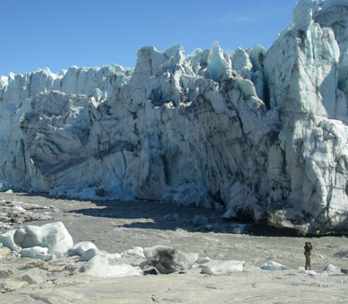Assessing the History of the Greenland Ice Sheet Through Ocean Drilling
November 7-9, 2011 – Corvallis, Oregon
Convener: Anders Carlson, Joseph Stoner
November 7-9, 2011 – Corvallis, Oregon
Convener: Anders Carlson, Joseph Stoner
Overview
 A workshop was convened to discuss new methodology, technologies, drilling locations and site surveying needed through which the International Ocean Discovery Program (IODP) can constrain the sensitivity of the Greenland Ice Sheet (GIS) to past climate changes, particularly during interglacial and earlier climate periods warmer than present. The impetus for this workshop directly stemmed from the IODP Science Plan for 2013-2023, where one of the major goals was to use ocean drilling to elucidate past GIS behavior. Participants included marine geologists, paleoceanographers, stratigraphers, geochemists, geophysicists, seismic surveyors, glaciologists, ice-sheet and climate modelers and those from the drilling communities that can provide information as to how best facilitate these objectives.
A workshop was convened to discuss new methodology, technologies, drilling locations and site surveying needed through which the International Ocean Discovery Program (IODP) can constrain the sensitivity of the Greenland Ice Sheet (GIS) to past climate changes, particularly during interglacial and earlier climate periods warmer than present. The impetus for this workshop directly stemmed from the IODP Science Plan for 2013-2023, where one of the major goals was to use ocean drilling to elucidate past GIS behavior. Participants included marine geologists, paleoceanographers, stratigraphers, geochemists, geophysicists, seismic surveyors, glaciologists, ice-sheet and climate modelers and those from the drilling communities that can provide information as to how best facilitate these objectives.
The participants concluded that process-oriented questions should be addressed that will inform on the GIS sensitivity to climate change. Specifically, what are the respective roles of atmospheric and oceanic forcings in controlling the extent of glaciation on Greenland? Is subsurface oceanic temperature important in predicting the behavior of the GIS? What is the role of buttressing ice shelves and sea ice? How does freshwater discharged from Greenland influence global ocean circulation? To answer these questions, three time intervals were identified. In the Miocene to Pliocene, the main goal is to document when and under what climate conditions Greenland’s valley glaciers expanded and became an ice sheet. In the Pliocene, the goal is to determine the volatility of the GIS to inform on the long-term sensitivity of this ice sheet to greenhouse gas concentrations similar to or slightly higher than current levels. In the Quaternary, the goal is to examine GIS behavior relative to climate both before and after the transition from 40 to 100 kyr glacial-interglacial cycles ~1 Ma ago. This would include expansions during global glacial maxima of different magnitudes (e.g., Marine Isotope Stages, MIS, 2, 4, 6, 8, 10 and 12), and the amount of inland ice retreat during interglacial boreal summer insolation maxima of different amplitudes (e.g., MIS 1, 5e, 7, 11, 19 and 31).
Workshop discussion focused on how ocean drilling can address these questions and scientific priorities. It was concluded that an extensive effort must be put into site surveying and coring well in advance of drilling around Greenland, both to refine scientific questions via regional process studies, and to locate the best drilling targets to address specific questions. Higher resolution preglacial and subglacial topographic maps of Greenland and its margin would help inform the selection of drill sites needed to document the early phases of late Neogene glaciation and identify major catchment basins of Greenland. As a drilling strategy, records from the continental slope and rise can inform on large-scale GIS changes whereas drilling on the continental shelf and in fjords will document instability of individual glacier systems. Significant progress is being made, although continued work is needed, on proxy development to track the areal extent of the GIS and date these proxies in sediment archives. Surface and subsurface ocean temperatures should be reconstructed in concert with the GIS records because ocean warming may play an important role in triggering ice-sheet instability and driving marine icemargin retreat, requiring near-field sea surface temperatures and more distal subsurface ocean temperature records from detailed depth transects. Sea-ice and ice-shelf records are also needed, because the GIS is sensitive to albedo/heat flux changes associated with sea-ice extent and the buttressing affect of potential ice shelves. Because of this broad spatial approach, developing drill-core chronologies that are independent of climate and correlatable between drill sites is needed for the successful reconstruction of paleo-GIS history. Ocean drilling is required around all of Greenland to document its late Neogene evolution and the sensitivity of different sectors to climate change. These activities should develop in close collaboration with the climate-ice sheet modeling community to create data-driven models, readily test hypotheses, and provide ice sheet-climate targets to the modeling community.
Steering Committee
Joseph Stoner (co-chair), Oregon State University
Anders Carlson (co-chair), University of Wisconsin-Madison
Henning Bauch, IFM-GEOMAR
Robert DeConto, University of Massachusetts-Amherst
Anne de Vernal, Université du Québec à Montréal
Julian Dowdeswell, University of Cambridge
Anne Jennings, University of Colorado
Alan Mix, Oregon State University
Eelco Rohling, University of Southampton
Guillaume St-Onge, Université du Québec à Rimouski
Workshop Sponsors
IODP U.S. Science Support Program
National Science Foundation
Past Global Changes (PAGES)